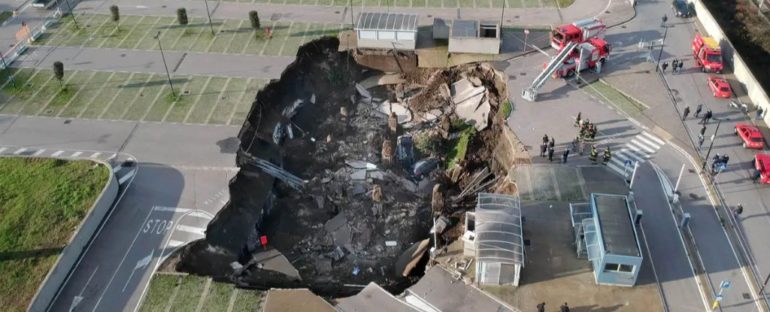First, it swallowed a car. A few hours later, two terraced buildings. At 9pm on January 20, a crater measuring 4 sq. meters appeared in Walmer Street, Manchester.
Another sinkhole shocked local Scottish walkers, swallowing a section of coastal path between Dysart and West Wemyss on February 4. And, in early March, a sinkhole in Cumbria opened up beneath a farmer riding a quad bike. He was rescued by firefighters and taken to hospital.
These are only recent examples from the UK. The ground opening up and engulfing whatever lies in its path is a pretty common occurrence. Globally, for every 0.1℃ rise in temperature, the number of sinkholes increases by 1-3 percent.
A particularly big sinkhole opened in Naples at 6.30am on January 8. The 20-meter deep, 50-meter wide hole suddenly appeared in the car park of the Ospedale del Mare Hospital. It swallowed an oblong section of the car park, caused a power cut and forced the temporary closure of a facility for coronavirus patients.
Aerial footage captures a sinkhole that opened in a hospital parking lot in Naples, Italy, forcing a residence for recovering COVID-19 patients to close temporarily.
Firefighters said there didn’t appear to be any injuries, but three cars did fall in. https://t.co/4pjpSI85ag pic.twitter.com/mqU8XRM4TT
— ABC News (@ABC) January 8, 2021
Sinkholes are particularly common in Naples. More than 190 have opened up in the city between 1915 and 2010, and there are about two to four major incidents per year.
A recent study on the historic canter of Naples has identified nine historical churches in imminent risk and a further 57 in potential risk of catastrophic ground collapse.
Sinkholes are not a new or even a bizarre phenomenon. They occur naturally when minerals below the land surface gradually dissolve in rainwater to form cavities. The sudden appearance of a sinkhole occurs when water loosens the soils around and above cavities just enough for the ground above to fall in.
But these scary phenomena are made a lot more common by humanity’s historical interference with the ground.
The growth in intrusive construction, deep mining, poorly managed burial of construction and demolition wastes and, crucially, changes in climate that have brought about heavier rainfalls have all caused the recent abnormal rise in number of sinkholes.
Most people don’t think much about the ground. Perhaps this isn’t surprising – there doesn’t seem much to consider.
Our relationship with it is usually one-way and with a single objective: we aim to “improve” it or exploit it to provide whatever functional service we seek – turning it into a strong foundation for buildings, or using it as a source of minerals or water.
But the ground is actually a complex and fine-tuned system, a combination of many components – rock, minerals, bacteria, plants – that work and live independently, but continuously interact with one another to create the solid surface and soil we live on and take for granted.
Disrupting these natural components and their harmony allows natural hazards such as sinkholes to occur.
The Naples sinkhole
Let’s use the Naples sinkhole to explore how this actually happens in practice.
The Ospedale del Mare Hospital sits on rock called “phonolitic tephrite”. The term tephrite comes from the Greek tephra, meaning ash. This is a porous and brittle rock with a distinct yellowish-grey color.
Roman builders first used this rock as building stone. Centuries of quarrying led to formation of a complex network of cavities beneath Naples, the like of which can be seen in the stone façade of Sarno Baths in Pompeii. The cavities underlie sandy ash and a top layer of urban soil mixed with wastes and construction rubble.
The top soil is rich in calcium and naturally interacts with carbon dioxide from the atmosphere to produce very soluble carbonates. This top soil was battered in three days of storms in December 2020.
It took five days for the flood water to seep into the ground through historical access shafts, washing away the soluble carbonates, loosening the cavity and triggering the sinkhole.
Conventionally, natural ground is engineered into foundation soil for buildings and roads by compacting and grouting (injecting chemicals like cement into the ground). Natural pores in soil are either destroyed or filled with chemicals.
For soil, less pores means better strength, but also means penetration of larger volumes of rainwater into the ground through fewer and narrower openings. This high intensity seepage can wash away soluble minerals, loosen the soil around buried cavities, and trigger sinkholes.
So how do we stop this from happening?
New groundwork
Over the past two decades, researchers have been trying to establish new methods of engineering the ground that satisfies the demands of cities but does not disrupt the ground’s natural systems.
For example, researchers at Strathclyde University have used fungi to form incredibly durable complex root-like networks of natural fibers in soil to hold it together. These are fibers that can even recover themselves in the face of damage.
And, in Newcastle, researchers are genetically engineering bacteria to make soil an “adaptive living material”, so that it strengthens itself in respond to load.
But the “products” of these techniques can clog the natural voids in soil. We are also yet to establish the effectiveness of these techniques in deeper grounds, particularly in urban soils, which are mixed with construction wastes.
My research team studies ways to strengthen natural voids in urban soil, from surface to depths, in three engineered layers: a crust, topsoil and subsoil.
We engineer natural bacteria in the crust to discharge a very sticky glue-like gel and bind soil grains together. Beneath, the topsoil is designed to be light, alive and breathable, rich in organic fibers that weave soil grains together.
We engineer these organic fibers to allow them to stretch far more before they rupture during ground movements. The subsoil in urban areas is usually rich in construction wastes. We develop ways for these wastes to feed on the carbon dioxide in soil and transform into very strong fibers.
Many engineers have come to see the way people treat the ground as unproductive, damaging and as backward as our treatment of endangered species, delicate ecosystems and the climate itself. We need to recruit the age-old natural engineering skills of the ground itself to build a more sustainable world.
Arya Assadi Langroudi, Senior Lecturer in Geotechnical Engineering, University of East London.
This article is republished from The Conversation under a Creative Commons license. Read the original article.



